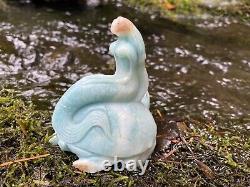
- Index
- Character
- Illustrator
- Signed
- Signed By
- Anna Zhou (2)
- Corbellic (78)
- David Frykman (2)
- Donald Trump (3)
- Eban Morales (20)
- G. Meynard Steith (4)
- Gwen Bentley (2)
- Jay Leisten (9)
- Jose Tonito (2)
- Lihi Neomi (2)
- Marina Sciascia (2)
- Monnie Wilson (2)
- Mr.koufay (7)
- Natalya (4)
- Neal Hefti (2)
- Ryan G Browne (2)
- Stan Lee (2)
- Steve Rude (2)
- Tone Rodriguez (2)
- Unsigned (2)
- Other (4221)
- Type
- Area Rug (143)
- Art (16)
- Artist Doll (27)
- Bowie (15)
- Bowie Knife (11)
- Comic Book (30)
- Drawing, Sketch (15)
- Fashion Doll (13)
- Figurine (111)
- Hunting (32)
- Painting (124)
- Photograph (34)
- Pocketknife (55)
- Print (14)
- Sculpture (37)
- Sports Trading Card (19)
- Statue (44)
- Table Lamp (40)
- Vase (23)
- Wood Carving (15)
- Other (3554)
- Universe
Amazonite Mermaid Stone Carving One Of A Kind Ocean Goddess Turtle Blue Crystal













8.3oz 4"x2"x3.5 Absolutely stunning very detailed hand carved mermaid sitting on top of a turtle. Carved from solid piece of Amazonite. I've actually held onto her for a long time. I had her on my water altar charging up in the mountain sun, and I've cleansed her in the stream next to our house.
She is ready to bestow you with powerful energy and bring joy and peace to your space! Amazonites best quality is its calming affect to the nervous system.
Below are descriptions of Amazonite, turtle meanings and mermaid lore! Amazonite is a variety of potassium feldspar and is the mineral class of Microcline.
It is part of the triclinic crystal system and has a vitreous luster. Amazonite comes in shades of purple, grey, green, and blue.
Most often it is a greenish blue color. The meaning of Amazonite is to soothe anxiety and bring clarity. Plunge into the cool coloring of Amazonite gemstones. Glimmering blue-green in its hues, Amazonite echoes with ancient tales, jungle magic, and the sweeping flow of one of the world's most mystical rivers.
Nicknamed The Hope Stone, Amazonite doesn't shy away from putting a positive spin on life but doesn't delve in blindly. It's a gemstone that calls on the spirit of inner strength, magnified intention and a commitment to using that can-do attitude to get what you want. This soulful gemstone has long been used as a talisman of truth and hope. As the gentle energetic flow of its color scheme suggests, it comes from the dense green riverbanks of South America's rainforests, where monkeys scramble and parrots bring a flash of exotic color to the trees.
Amazonite can also be found on the vanilla-scented sands of Madagascar and the icy depths of Russia's tundra. It's a stone that is mined in the most extraordinary of places and perhaps this adds to its mystical and watery nature. Amazonite has been around forever, and legend has it - this was the stone that lined the shields of the mythical Amazonian warrior princesses.The grace and glory of Amazonite spans centuries, it was also the gemstone that adorned the temples and tombs of Tutankhamun and was used to make the tablets that formed the elusive Book of the Dead. But even grandiose historical connections aside, strong healing properties and deep-set connections to the heart chakra and the throat chakra mark out the Amazonite stone as being something special. If you dream of living deeper, standing strong and proud in your authentic light and manifesting universal love, choosing to use Amazonite could be one of the best decisions you make.
Delve a little deeper into the queen of green stones and take a closer look at the hidden magic and meanings behind the amazing Amazonite gemstone. Among the rampant tall tales that have entertained humankind for millennia, mermaid mythology is unique because of the way these sea creatures have been depicted in various cultures. Some see them as magical and benevolent creatures, while others consider them to be harbingers of disaster.
Although they are widely regarded as fictional characters, people have claimed sightings of mermaids throughout history. This begs the question: Are mermaids real? The first known mermaid folklore came from Assyria, an ancient civilization that existed in what is now northern Iraq. The story (which dates from around 1,000 BC) states that the first mermaid was the goddess Atargatis. She fell in love with a human shepherd, but ends up killing him accidentally. The goddess was so ashamed that she threw herself into a lake, intending to become a fish for all eternity; however, her beauty could not be concealed by the lake. Thus, she assumed the tail of a fish and the upper body of a human and became the first mermaid. In ancient Greek tales, the sister of Alexander the Great was turned into a mermaid upon her death, and her spirit ended up in the Aegean Sea. The response was indeed he was alive and was conquering the world. This news brought her so much joy that she made the sea calm for the sailors to safely navigate their way through. Asian cultures regard the mermaid as a creature of wonder.Chinese folklore describes mermaids as being capable of shedding tears that turn into pearls. They could also knit a valuable material that was as white as frost and could never become wet. For these reasons, mermaids were sought after by fishermen. However, fishermen who set sail to hunt mermaids were viewed negatively because these creatures were believed to epitomize grace and beauty.
The Japanese version of this legendary creature was depicted more grotesquely, without the Western concept of a human torso. Instead, they only had a human head attached to a fish's body. This misshapen creature had supernatural powers and had flesh that, when consumed, could grant the eater immortality.However, catching one was thought to bring about storms and bad luck, so any catch was thrown back to the sea. If a mermaid were to wash up on shore, it was an omen for impending warfare or catastrophe.
The British are less enamored with the mermaid, believing her to be the creator of misfortune at sea. While some mermaid myths claim that mermaids aren't aware or forget that humans cannot breathe underwater, it is more often told that the mermaid is a mischievous creature, with every intention of seducing sailors to lead them to a watery grave. One thing is certain for British sailors: A mermaid sighting is a sure sign of bad luck. Of course, no article about mermaids can go without any mention of the tale that inspired the well-known Disney film The Little Mermaid. This animated feature was a sanitized version of the original Hans Christian Andersen fairy tale published in 1837. The tale was based on legends about stunningly beautiful mermaids who would shed their fish scales in order to roam on dry land as human women. While it has never been conclusively proven that mermaids exist, sightings persist into the modern era. A town in Israel once offered a million dollar reward to anyone who could prove the existence of mermaids after dozens of people reported seeing one leaping like a dolphin off the coast. Many folklorists think that the vast majority of mermaid sightings were actually misinterpreted seal sightings. Are Mermaids Good or Evil? As many of the stories indicate, cultures around the world have had varying opinions about mermaids. Some mermaids, like Atargatis, were believed to be divine and were revered as such. Other cultures were more wary of mermaids, regarding them as crafty tricksters who were always ready to prey on the vulnerable. Mermaid sightings have been viewed as warnings of forthcoming storms and omens of shipwrecks. And like the sirens of ancient Greek mythology, mermaids were sometimes viewed as predatory creatures who liked dragging people to the water in order to drown them. Some stories, however, speak of mermaids who granted wishes and provided cures to grave illnesses. A few mermaids even marry and live with humans.It's no secret that the possibility of this creature existing has fascinated human beings for thousands of years. Mermaid myths weren't just created for mankind's entertainment, however. Myths are created as a means of explaining the unexplainable.
This is why, before the dawn of modern science and technology, some cultures blamed storms and other destructive natural phenomena on mermaids. While the existence of mermaids has never been proven, it's important to remember that some of the strangest sea creatures that are widely known and studied today were once unknown. Perhaps you'll be the first person to ever record a live mermaid on video on your next dive. Turtles were often found in Egyptian art, often as hieroglyphics, but vases in the shape of these creatures have been unearthed. In pre-dynastic times, turtle amulets were believed to ward off evil and defend health and life.
By the time of the Middle Kingdom, knives with turtle carvings were supposed to be protectors of women and children. In mythology, the turtle was associated with Set and the Underworld. Because of this, they were divine enemies of Ra and an activity of kings in the Greco-Roman period was spearing turtles to destroy evil. Associated with the water god, Enki, the turtle served as a symbol of the god. In Ninurta and the Turtle, the god of farming's world domination attempt is thwarted by Enki with the creation of a giant turtle who bites Ninurta's ankle. The two then struggle until the turtle uses its claws to dig a pit and drags them both into it. In the ancient Book of Ceremonies, the tortoise is one of four entities which possess spirit. Associated with divination, tortoise shells carry some of the oldest examples of Chinese writings. It is also one of the Four Prominent Beasts, which rules the north and symbolizes longevity, endurance, and strength. For Chinese lore, it was believed a tortoise helped Pangu create the world and so, the turtle and tortoise are a symbol of the universe.It is also said tortoise come out in the spring to change their shells and hibernate in the winter, which is why they live long. It should be noted, however, that while tortoises hibernate, they cannot remove their shells as it is a part of their exoskeleton. It should be noted that calling someone a "tortoise" in China was considered offensive.
This is because of the story of tortoises not being able to recall their date of birth. It is believed four elephants stand on the back of a turtle to hold up the world.
In Hinduism, however, only a turtle carries the world on its back. To many indigenous groups, the World Turtle carries the earth on its back. Sometimes, the continent is called Turtle Island. In many cultural traditions, the turtle also decided the lunar calendar, with the thirteen scales on its shell representing thirteen full moons in a year and the twenty-eight sections on the outer rim of their shells representing twenty-eight days in a month.
The tortoise is the personification of the war god, Tu. For warriors, a traditional custom was to draw tattoo marks of tortoises on their skin. It is also said in some creation stories that people are born from eggs laid by the World Turtle.
